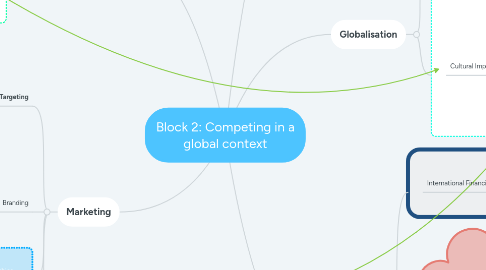
1. Global Trade Environment
1.1. Competition
1.1.1. Theories of Advantage
1.1.1.1. Comparative
1.1.1.1.1. Absolute
1.1.1.1.2. Relative
1.1.1.2. Competitive
1.1.1.2.1. Diamond Model
1.1.1.2.2. Five Forces Model
1.1.2. Among Countries
1.1.3. Among Business
2. Globalisation
2.1. Connectedness
2.1.1. 'Shrunken World'
2.1.1.1. Social Media
2.1.1.2. Global news
2.1.2. Technological Advancements
2.2. Cultural Impacts
2.2.1. Cross-Culture
2.2.1.1. Convergence
2.2.1.2. Divergence
2.2.1.3. Crossvergence
2.2.2. Ethical Concerns
3. The role of HRM
3.1. Managing Employee Interests
3.2. Plays a role in market attractiveness
3.3. Culture
3.3.1. Meeting Cultural Needs
3.3.2. Managing Cultural Differences
4. Marketing
4.1. Targeting
4.1.1. Demographics
4.1.1.1. Age
4.1.1.2. Ethnicity
4.1.1.3. Nationality
4.1.2. Geography
4.1.2.1. Climate
4.1.2.2. Topography
4.1.3. Advertising
4.2. Branding
4.2.1. Global Brands
4.2.2. International Brands
4.2.3. Local Brands
4.2.4. Kapferer 2004, 2012
4.3. Ethics
4.3.1. Corporate Social Responsibility
4.4. Expanding Globally
4.4.1. Market Attractiveness
4.4.2. Benefits
4.4.3. Challenges
5. Finance
5.1. International Financial Institutions
5.1.1. IMF
5.1.1.1. Aiding Countries in financial Turmoil
5.1.2. World Bank
5.1.2.1. Ending extreme poverty
5.2. Multinationals
5.2.1. Advantages
5.2.1.1. Innovating Products
5.2.1.2. Free Services
5.2.2. Disadvantages
5.2.2.1. Tax Avoidance
5.2.2.2. Wealth Imbalance
5.3. Raising Funds
5.3.1. Traditional Sources
5.3.1.1. Retained Earnings
5.3.1.2. Bank Overdrafts
5.3.1.3. Bank Facilities
5.3.1.4. Leasing
5.3.1.5. Equity Finance
5.3.2. Alternative Sources
5.3.2.1. Crowdfunding
5.3.2.1.1. Gift and reward
5.3.2.1.2. Equity Crowdfunding
5.3.2.2. Peer To Peer Lending
